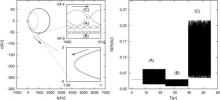
Abstract
The tidal breakup of binary star systems by the supermassive black hole (SMBH) in the center of the galaxy has been suggested as the source of both the observed sample of hypervelocity stars (HVSs) in the halo of the Galaxy and the S-stars that remain in tight orbits around Sgr A*. Here, we use a post-Newtonian N-body code to study the dynamics of main-sequence binaries on highly elliptical bound orbits whose periapses lie close to the SMBH, determining the properties of ejected and bound stars as well as collision products. Unlike previous studies, we follow binaries that remain bound for several revolutions around the SMBH, finding that in the case of relatively large periapses and highly inclined binaries the Kozai resonance can lead to large periodic oscillations in the internal binary eccentricity and inclination. Collisions and mergers of the binary elements are found to increase significantly for multiple orbits around the SMBH, while HVSs are primarily produced during a binary's first passage. This process can lead to stellar coalescence and eventually serve as an important source of young stars at the galactic center.